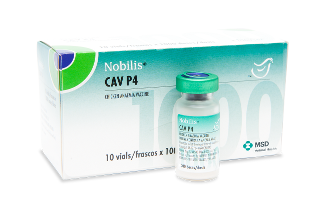Nobilis® CAV P4
This is a live attenuated freeze-dried vaccine containing chicken anaemia vaccine virus.
Nobilis® CAV P4 is intended for the immunisation of healthy future breeding chickens against chicken anaemia.

FOR ANIMAL USE ONLY
NOBILIS® CAV P4
Reg. No. G2467 (Act 36/1947)
Namibia Reg No. V98/24.3/673 [NS0]
INDICATIONS
This is a live attenuated freeze-dried vaccine containing chicken anaemia vaccine virus.
Nobilis® CAV P4 is intended for the immunisation of healthy future breeding chickens against chicken anaemia.
COMPOSITION
Each 1 mℓ dose contains at least 2,3 log10 TCID50 of chicken anaemia vaccine virus propagated on embryonated eggs. The freeze-dried pellet contains stabilisers.
IMMUNITY
The induction of high neutralising antibody levels is generally dependent on the health and condition of the chickens. Hygiene and management are also important in the post-vaccination period. Breeding chickens must be vaccinated at least 6 weeks before the onset of lay.
STORAGE
- Store in the dark between 2 °C and 8 °C.
- Do not freeze.
- Avoid prolonged or repetitive exposure to high ambient temperatures following withdrawal from the refrigerator prior to use.
- Protect from direct sunlight.
- The diluent may be stored at room temperature (20 °C to 25 °C) prior to use.
WARNINGS
- The vaccine must not be administered to chickens under 6 weeks of age.
- Breeding chickens have to be vaccinated at least 6 weeks before the onset of lay.
- It is advisable to vaccinate all the susceptible chickens on the farm at the same time. If this is not feasible, strict separation of vaccinated and unvaccinated chickens should be done to prevent the spread of the vaccine virus to the unvaccinated chickens.
- Wash and disinfect hands and equipment after vaccinating.
- Do not open and reconstitute the vaccine until ready to start vaccination.
- Use the vaccine immediately after reconstitution.
- Do not store partially used containers for future use.
- Use according to the number of doses as indicated on the label.
- Destroy any unused, reconstituted vaccine, empty vaccine containers, needles, etc. according to local waste disposal regulations after completion of the vaccination.
- KEEP OUT OF REACH OF CHILDREN, UNINFORMED PERSONS AND ANIMALS.
- Although this vaccine has been extensively tested under a large variety of conditions, failure thereof may ensue as a result of a wide range of reasons. If this is suspected, seek veterinary advice and notify the registration holder.
PRECAUTIONS
- Only healthy chickens should be vaccinated.
- Observe aseptic precautions. Ensure that all vaccination equipment (needles, syringes, etc.) are clean and sterile before use.
- The vaccination equipment used should be free from traces of disinfectant or spirit.
- Ensure that all equipment is kept clean and sterile during use.
- Each vial should be used immediately after opening.
- Avoid intravenous injection.
- It is good vaccination practice to avoid contact with the eyes, hands and clothing when handling the vaccine.
DIRECTIONS FOR USE – USE ONLY AS DIRECTED
Intramuscular and Subcutaneous Injection
- Reconstitute the vaccine with Intervet’s diluent, Dilavia.
- Add some of the diluent to the vaccine vial, using a sterile syringe and needle, and shake.
- Withdraw the rehydrated vaccine into the syringe and add the rest of the diluent.
- Gently shake to mix.
- Withdraw a portion of the diluent to flush the vial and inject the fluid back into the diluent bottle.
- Remove the syringe.
- Fill the automatic syringe according to the manufacturer’s recommendation and set the dose to 0,2 mℓ.
Dosage
Every 0,2 mℓ contains 1 chicken dose (The amount of diluent to be used depends on the number of doses per vial). Administer the vaccine by the intramuscular or subcutaneous route.
Application by the Wing web method
- Reconstitute the vaccine with the appropriate amount of diluent.
- The vaccine is supplied with 200 mℓ diluent and a double needle.
- After reconstitution of the vaccine with the diluent the wing web needle is dipped into the vaccine solution, before the vaccination of each chicken, so that both grooves are filled.
- The needle is inserted through the wing web from beneath, taking care to avoid the feathered parts of the web.
- After 7 to 10 days of vaccination, the reaction should be examined in a certain number of chickens.
- The vaccination site should show minor swelling and small scabs which will disappear within 2 to 3 weeks.
VACCINATION PROGRAMME
The optimum time and method of administration depend largely upon the local situation. Therefore, the advice of a veterinarian should be sought. Under no circumstances should the vaccine be administered under 6 weeks of age. To make sure that adequate antibody levels are built up at the onset of lay, breeding chickens have to be vaccinated at least 6 weeks before this onset.
Vaccination against CAV can be combined with vaccination against Reo (intramuscular or subcutaneous route) or with vaccination against Chicken Pox (wing web route)
PRESENTATION
Boxes containing 10 vials of 1 000 doses each with diluent (Dilavia) and wing web needle.
REGISTRATION HOLDER MANUFACTURER
Intervet South Africa (Pty) Ltd. Intervet International B.V.
20 Spartan Road Wim de Körverstraat 35
Spartan, 1619, RSA 5831AN Boxmeer
Tel: +27 (0) 11 923 9300 The Netherlands
E-mail: msdahza@msd.com
www.msd-animal-health.co.za
DATE OF PUBLICATION OF THIS PACKAGE INSERT
26 February 1998
